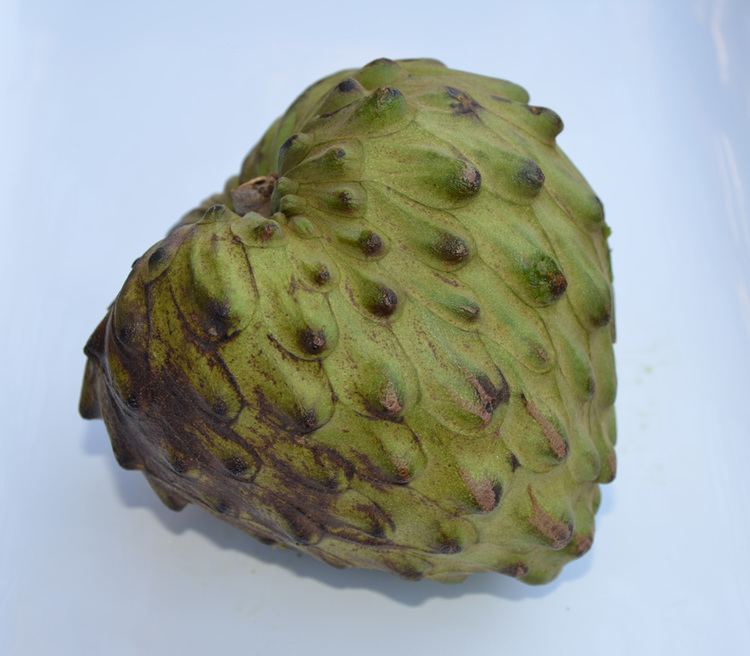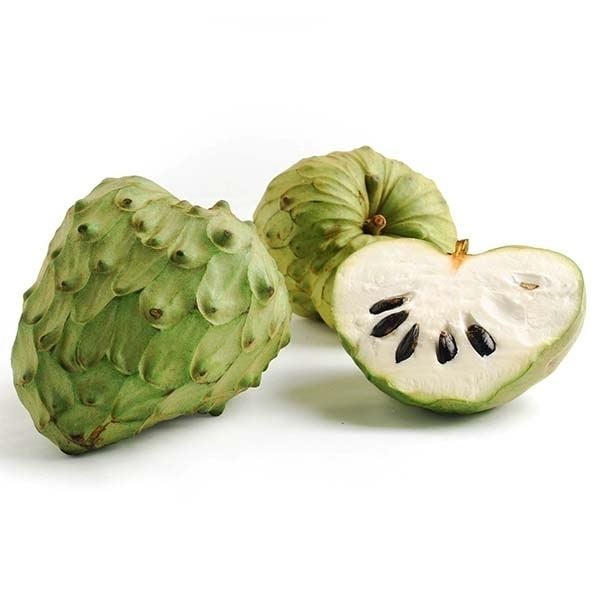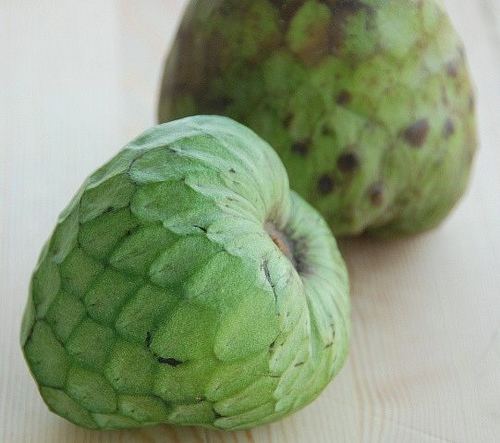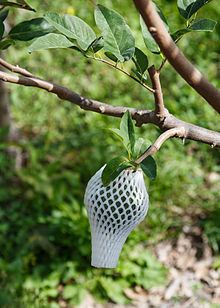Species A. cherimola | ||
 | ||
Similar | ||
How to eat a cherimoya fruit custard apple
The cherimoya (Annona cherimola), also spelled chirimoya and called Chirimuya by the Inca people, is an edible fruit-bearing species of the genus Annona from the family Annonaceae, which generally is thought to be native to Ecuador, Colombia, Peru and Bolivia then transported to the Andes and Central America. Today, cherimoya is grown throughout South Asia, Central America, South America, California, Hawaii, southern Europe, East Africa, Kisii in particular and northern Africa.
Contents
- How to eat a cherimoya fruit custard apple
- Description
- Etymology
- Indigenous cultures
- Pollination
- Distribution
- Cultivation and harvesting
- Eating characteristics
- Nutritional value
- Postharvest handling
- Chirimoya of the Granada Mlaga Tropical Coast
- References

Mark Twain called the cherimoya "the most delicious fruit known to men". The creamy texture of the flesh gives the fruit its secondary name, custard apple.

Description

Annona cherimola is a fairly dense, fast-growing, woody, briefly deciduous but mostly evergreen low branched, spreading tree or shrub 5 metres (16 ft) to 9 metres (30 ft) tall.

Etymology
The name originates from the Quechua word chirimuya, which means "cold seeds", because the plant grows at high altitudes and the seeds will germinate at higher altitudes. In Bolivia, Peru, Chile, Ecuador and Colombia the fruit is commonly known as chirimoya (spelled accordingly with the Spanish language rules).
Indigenous cultures
The Moche culture of Peru had a fascination with agriculture and represented fruits and vegetables in their art. Cherimoyas were often depicted in their ceramics.
Pollination
The flowers are hermaphroditic and have a mechanism to avoid self-pollination. The short-lived flowers open as female, then progress to a later, male stage in a matter of hours. This requires a separate pollinator that not only can collect the pollen from flowers in the male stage, but also deposit it in flowers in the female stage.
Studies of insects in the cherimoya's native region as its natural pollinator have been inconclusive; some form of beetle is suspected. Quite often, the female flower is receptive in the early part of the first day, but pollen is not produced in the male stage until the late afternoon of the second day. Honey bees are not good pollinators, for example, because their bodies are too large to fit between the fleshy petals of the female flower. Female flowers have the petals only partially separated, and the petals separate widely when they become male flowers. So, the bees pick up pollen from the male flowers, but are unable to transfer this pollen to the female flowers. The small beetles which are suspected to pollinate cherimoya in its land of origin are much smaller than bees.
For fruit production outside the cherimoya's native region, cultivators must either rely upon the wind to spread pollen in dense orchards or else use hand pollination. Pollinating by hand requires a paint brush. Briefly, to increase the fruit production, growers collect the pollen from the male plants with the brush, and then transfer it to the female flowers immediately or store it in the refrigerator overnight. Cherimoya pollen has a short life, but it can be extended with refrigeration.
Distribution
Widely cultivated now, Annona cherimola is believed to originate from the Andes at altitudes of 700 metres (2,300 ft) to 2,400 metres (7,900 ft) although an alternate hypothesis postulates Central America as the origin of Annona cherimola because many of its wild relatives occur in this area. From there it was taken by Europeans to various parts of the tropics. Unlike other Annona species A. cherimola has not successfully naturalized in West Africa, and in Australasia Annona glabra is often misidentified as this species.
Cultivation and harvesting
Annona cherimola, preferring the cool Andean altitudes, hybridizes with the other Annona species and a hybrid with A. reticulata called atemoya has received some attention in West Africa. Along with other Annona species, Annona cherimola has been shown to possess antioxidant activity in its flesh and skin components
The tree thrives throughout the tropics at altitudes of 1,300 to 2,600 m (4,300 to 8,500 ft). Though sensitive to frost, it must have periods of cool temperatures or the tree will gradually go dormant. The indigenous inhabitants of the Andes say the cherimoya cannot stand snow.
In the Mediterranean region, it is cultivated mainly in southern Spain and Portugal, where it was introduced between 1751 and 1797 from where it was carried to Italy, but now can be also found in several countries of Africa, the Middle East and Oceania. It is cultivated throughout the Americas, including Hawaii since 1790 and California where it was introduced in 1871.
Large fruits which are uniformly green, without cracks or mostly browned skin, are best. Unripe cherimoyas will ripen at room temperature, when they will yield to gentle pressure.
Exposure to ethylene (100 ppm for one to two days) accelerates ripening of mature-green cherimoya and other Annona fruits; they can ripen in about five days if kept at 15 to 20 °C (59 to 68 °F). Ethylene removal can be helpful in retarding ripening of mature-green fruits.
Eating characteristics
Different varieties have different flavors, textures, and shapes. Shapes can range from imprint areoles, flat areoles, slight bump or point areoles, full areoles, and combinations of these shapes. The flavor of the flesh ranges from mellow sweet to tangy or acidic sweet, with variable suggestions of pineapple, banana, pear, papaya, strawberry or other berry, and apple, depending on the variety. The usual characterization of flavor is "pineapple/banana" flavor, similar to the flavor of the Monstera deliciosa fruit.
When the fruit is soft-ripe/fresh-ripe and still has the fresh, fully mature greenish/greenish-yellowish skin color, the texture is like that of a soft-ripe pear and papaya. If the skin is allowed to turn fully brown, yet the flesh has not fermented or gone "bad", then the texture can be custard-like. Often, when the skin turns brown at room temperature, the fruit is no longer good for human consumption. Also, the skin turns brown if it has been under normal refrigeration for too long - a day or two maybe.
Nutritional value
In a 100 g serving providing 75 calories, cherimoya is an excellent source (> 19% of the Daily Value, DV) of vitamin B6 and a good source (10-19% DV) of vitamin C, dietary fiber and riboflavin (table).
Postharvest handling
The optimum temperature for storage is 8–12 °C (46–54 °F), depending on cultivar, ripeness stage, and duration, with an optimum relative humidity of 90-95%.
Chirimoya of the Granada-Málaga Tropical Coast
The Chirimoya of the Granada-Málaga Tropical Coast is a fruit of the cultivar ‘Fino de Jete" grown in the Granada-Málaga tropical southern coast of Spain with the EU's appellation protected designation of origin status.
This variety is prepared and packed in the geographical area because "it is a very delicate perishable fruit and its skin is very susceptible to browning caused by mechanical damage, such as rubbing, knocks, etc. The fruit must be handled with extreme care, from picking by hand in the field to packing in the warehouse, which must be carried out within 24 hours. Repacking or further handling is strictly forbidden."
